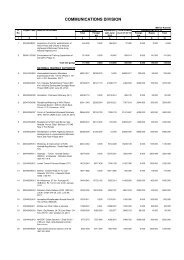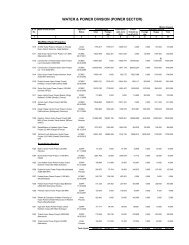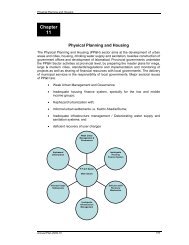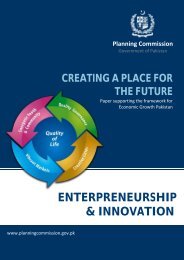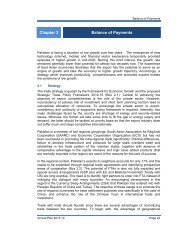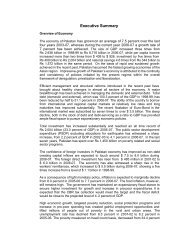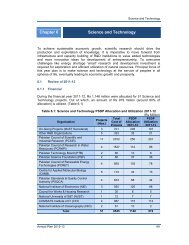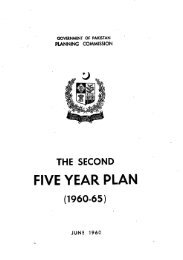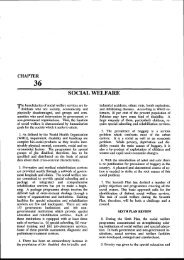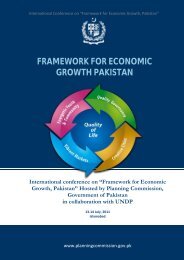Manual for Development Projects - Planning Commission
Manual for Development Projects - Planning Commission
Manual for Development Projects - Planning Commission
Create successful ePaper yourself
Turn your PDF publications into a flip-book with our unique Google optimized e-Paper software.
Chapter-1<br />
a realistic statement of the goals to be achieved. It gives a sense of direction to the current<br />
economic policies. It establishes targets of massive improvement to be brought about in living<br />
standards by mobilizing the resources and energies of the nation".<br />
1.30 The period is necessarily arbitrary and there is no profound reason <strong>for</strong> its determination<br />
but it seems to be, on the one hand, long enough to permit a meaningful structural change in the<br />
economy and, on the other, not so long as to be without direct interest to the present working<br />
generation. More specifically, five year plans are inadequate as a framework <strong>for</strong> targets and<br />
policies <strong>for</strong> other reasons. Many short term decisions have a bearing on long-term growth. If<br />
these decisions are taken without considering their implications <strong>for</strong> the years beyond the current<br />
five year plan, there is a danger of unexpected future imbalances. Economic growth is a<br />
continuous process so that planning <strong>for</strong> it calls <strong>for</strong> the integration and adjustment of short-term,<br />
intermediate and long-term programmes.<br />
1.31 The seventh five year plan puts the perspective plan in the following words:<br />
"Social change is a complex long-term process. It involves changes in values and ideas in<br />
social, political and economic spheres and innovations in the utilization of natural resources. It<br />
is useful to look from time to time at economic development in its wider context, and to prepare<br />
long term plans, more by way of setting distant guideposts than as a real ef<strong>for</strong>t to achieve<br />
specific targets. Obviously, given the uncertainties attaching to even nearer-term projections, a<br />
perspective plan cannot be a specific blueprint <strong>for</strong> action. The second perspective plan has been<br />
developed to visualize the desired profile of Pakistan in the year 2003, and outline a broad<br />
approach to key problems which may arise".<br />
Public Sector <strong>Development</strong> Programme (PSDP)<br />
Page 7 of 13<br />
1.32 The Public Sector <strong>Development</strong> Programme (PSDP) is an annual document which lists all<br />
the public sector projects/ programmes with specific allocations made <strong>for</strong> each one of them in<br />
that particular financial year. It is the operational side of the Five Year and Annual Plans. In<br />
other words, it is that part of the country's annual budget which deals with development<br />
expenditure, that is, it indicates the total cost of the project, <strong>for</strong>eign exchange component of the<br />
total cost, expenditure incurred upto the end of last financial year, PSDP allocation <strong>for</strong> the<br />
current financial year together with its <strong>for</strong>eign aid component.<br />
1.33 The PSDP procedure differs from the project approval procedure. Due to the general<br />
constraint which exists on government funds, projects are competing <strong>for</strong> a limited amount of<br />
funds available <strong>for</strong> development. An essential part of the procedure, there<strong>for</strong>e, is a shift from<br />
the examination of a project in isolation to the selection of a limited number of projects out of a<br />
much larger portfolio.<br />
1.34 The preparation of the PSDP is co-ordinated by the Programming Section of the <strong>Planning</strong><br />
and <strong>Development</strong> Division. The procedure is laid down in detail in a PSDP call letter sent<br />
annually to all Government Ministries/Divisions, Provincial Governments and Chiefs/Heads of<br />
Technical Sections of the <strong>Planning</strong> and <strong>Development</strong> Division. The call letter includes a timeschedule<br />
and a standard pro<strong>for</strong>ma alongwith guidelines on the preparation of the PSDP and<br />
selection of projects. The procedure starts in October/November each year. A copy of the letter<br />
http://hd2/pc/popup/ch1_p.html<br />
9/23/2010




